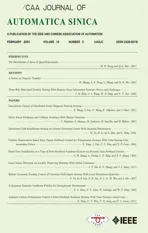Three-Way Behavioral Decision Making With Hesitant Fuzzy Information Systems:Survey and Challenges
2023-03-09JianmingZhanJiajiaWangWeipingDingandYiyuYao
Jianming Zhan,Jiajia Wang,Weiping Ding,,and Yiyu Yao
Abstract—Three-way decision (T-WD) theory is about thinking,problem solving,and computing in threes.Behavioral decision making (BDM) focuses on effective,cognitive,and social processes employed by humans for choosing the optimal object,of which prospect theory and regret theory are two widely used tools.The hesitant fuzzy set (HFS) captures a series of uncertainties when it is difficult to specify precise fuzzy membership grades.Guided by the principles of three-way decisions as thinking in threes and integrating these three topics together,this paper reviews and examines advances in three-way behavioral decision making (TW-BDM) with hesitant fuzzy information systems (HFIS) from the perspective of the past,present,and future.First,we provide a brief historical account of the three topics and present basic formulations.Second,we summarize the latest development trends and examine a number of basic issues,such as one-sidedness of reference points and subjective randomness for result values,and then report the results of a comparative analysis of existing methods.Finally,we point out key challenges and future research directions.
I.INTRODUCTION
RANKING,selecting the best solution,and decisions are common actions and ultimate goals of decision making.Decision making is everywhere [1]–[3].Both the small issue of employment choices [4] and the implementation of national policies [5] are common decision making processes.However,in the case of insufficient experiences,decision making problems often contain hesitant fuzzy (HF) information [6],[7].Therefore,a hesitant fuzzy information system(HFIS) is a valid expression form of uncertain information.For instance,the evaluation of supply chain analysis tools [8] and enterprise project planning [9] can be modeled as HF decision making problems.At present,the solution for various problems under HFISs is one of the key topics for scholars.
In view of the reason that the three-way decision (T-WD)theory is a valid tool for coping with uncertain issues and the behavioral decision making (BDM) theory can scientifically describe the psychological behaviors of decision makers(DMs),the T-WD model based on the BDM theory can be more reliable and suitable for addressing practical decision making issues.This paper reviews three-way behavioral decision making (TW-BDM) methods on HFISs.Therefore,the layout of this review article is arranged as follows: First,the development process of T-WD,hesitant fuzzy sets (HFSs) and the BDM theory are introduced.Then,the development of TW-BDM methods is reviewed.
Although there have been many excellent research achievements under HFISs,there is no survey that comprehensively reviews contributions and deficiencies of existing works.Therefore,this paper mainly focuses on the algorithmdesign of decision making models,and shows shortcomings of existing models,thereby inspiring related researchers to investigate.Therefore,the main motivations and contributions of this study are summarized as follows:
1) Uncertainties in Realistic Decision Making:From mathematics to computing,management applications and other fields,uncertainties have been the subject of long-termresearch [10].For the uncertain problem of hesitancies,HFISs can accurately reflect realistic decision making situations,which can not only evaluate the object from multiple perspectives,but also the evaluation value is composed of several possible values.Moreover,the T-WD theory was proposed by Yao [11] on the basis of original rough sets and decision-theoretic rough sets,which is an effective tool to deal with uncertainty problems in accordance with human cognition,and can choose reasonable and effective decision making actions according to the loss of different actions in different states.Given the advantages of HFISs and the T-WD theory,the primary motivation of this paper is to review and survey the development of HFISs and T-WD models.
2) Limited Rationality:DMs are one of the influencing factors in decision making.DM s are not machines that execute command codes,but have their own subjective thoughts.Generally speaking,realistic decision making processes have limited rationality,and a completely rational decision making process is rare.This is especially true for uncertain decision making processes where available information is insufficient.Therefore,determining how to scientifically reflect the subjective preferences of DM s is very important.Prospect theory(PT) [12] studies how DMs make decisions under uncertain conditions,which reveals that DMs have the following characteristics when choosing: a deterministic effect,reflex effect,loss aversion,small probability obsession and referential dependence,and it is widely applied to behavioral finance,multi-attribute decision making (MADM) and other fields.In conclusion,another motivation for this paper is to review and survey the development of PT in the field of uncertain decision making.
3) Anticipated Response:is another psychological behaviors of DMs,which is an anticipation expression for future events.Bell [13] described regret as the emotion that arises from comparing the outcome or state of one event with another.The regret-rejoice function in the regret theory (RT)can quantify this anticipated response of DM s.Furthermore,it has two main conclusions: one is that DMs pay more attention to regret than rejoicing.Another is that DMs are more averse to regret,hence they will avoid choosing actions that produce regret.Therefore,reviewing and surveying existing research results of RT is another research motivation of this paper.
4) Contributions:of this paper are presented as follows: By summarizing existing research results,on the one hand,it expounds the innovations,contributions and deficiencies of existing researches.On the other hand,it points out that the research on T-WD in a hesitant fuzzy environment (HF TWD) model based on BDMis still not perfect.Finally,in order to promote the development of HFISs in the decision making field,some potential research directions are summarized.
In addition,considering the length of the paper,this paper only covers some other relevant decision making literatures,but does not discuss them in depth,and readers can learn by themselves.Thus,the overall organization of this paper is arranged as follows: In Section II,we review basic formulations of the three theories.In Section III,we list a historical account of three theories.In Section IV,a bibliometric analysis of the three theories is carried out.In Section V,some methods of current research are analyzed.In Section VI,some topics worthy of future research are pointed out.In Section VII,contributions of this paper are summarized.
II.BASIC FORMULATIONS OF THREE THEORIES
Before conducting a comparative analysis,we first review the basic notions and terminologies of the T-WD theory,HFSs,PT and RT.
A.Three-Way Decisions
The T-WD theory is a decision making theory that obeys to human cognition proposed by Yao [11] from Regina University in Canada.The original motivation was to provided a logical semantic interpretation for positive,boundary and negative domains of concepts in rough sets [14].After that,with the continuous in-depth study of T-WD models,it is gradually divided into a narrow sense model and a wide sense model.
1) The Narrow Sense of Three-Way Decisions:In the narrow T-WD,the object includes two state setsS,,and three actionsA p,A b,A n.Moreover,Sandare the state sets onU,which respectively represent the set of objects that meet the condition and those that do not.A p,A b,A nstand for the acceptance,consideration and rejection actions,respectively.
The object for taking three actions in each state are accompanied by losses.The details are shown in Table I.In specific,L∗pdenotes the loss value of the object takingA∗(∗=p,b,n)inS.Similarly,L∗ndenotes the loss value of the object takingA∗(∗=p,b,n) in

TABLE I THE LOSS INFORMATION TABLE
Then,based on the state setSand the equivalence class [o]of the object,the conditional probability Pr(S|[o]) of the object can be calculated.Among them,[o] is the set induced by the equivalence relationRon the universeU,which is called the equivalence class.[o]=v∈U|(x,v)∈R.In the classic T-WD[11],the membership degree of the object belonging to the state setShas only two values of 0 and 1,and the calculation formula of the conditional probability Pr(S|[o]) can be equivalent to the following form:
whereX S(v) is the membership degree that the objectvbelongs to the state setS.
By combining the loss information with conditional probabilities,the expected loss values of objects under different actions can be obtained.
In light of the minimumrisk principle of Bayesian decision processes [15],the following decision rules can be established:
(P) IfE(p|[o])≤E(b|[o])andE(p|[o])≤E(n|[o]),decideo∈Pos(S);
(B) IfE(b|[o])≤E(p|[o])andE(b|[o])≤E(n|[o]),decideo∈Bnd(S);
(N) IfE(n|[o])≤E(p|[o])andE(n|[o])≤E(b|[o]),decideo∈Neg(S).
According to the classification results,the corresponding strategies of objects are: accepting the objects inPos(S),considering the objects inBnd(S),rejecting the objects inNeg(S).
A fterwards,Jia and Liu [16] proposed a relative loss function from the perspective of the object’s evaluation value as the state of wealth.The details are shown in Table II.

TABLE II THE RELATIVE LOSS INFORMATION TABLE BASED ON THE EVALUATION VALUE eij
In Table II,eijis an evaluation value of the objectoiunder the attributeC j,ϱdenotes the risk aversion coefficient,which measures a DM’s ability to take risks.The largerϱ,the easier it is for a DM to make a definite decision making.andare the maximumand minimumvalues of all evaluation information under the attributeCj,respectively.
The relative loss function greatly reduces the subjective arbitrariness of T-WD,and also unifies the loss value of an object with its own wealth (evaluation value).
2) The Wide Sense of Three-Way Decisions:With the continuous development of T-WD theory and its applications,the T-WD theory is not limited to making decisions via the conditional probability and loss function of the object.At this time,the wide T-WD theory came into being.
The wide sense of T-WD refers to: A philosophy of thinking in threes,a methodology of working in threes,a mechanism of processing in threes.Afterwards,Yao [17] gave the graphic representation and semantic explanation of the wide sense of T-WD from geometrical perspectives.The trisectingacting-outcome (TAO) model [18],[19] can demonstrate the ternary thinking framework of the wide sense of T-WD well.The specific formis shown in Fig.1.
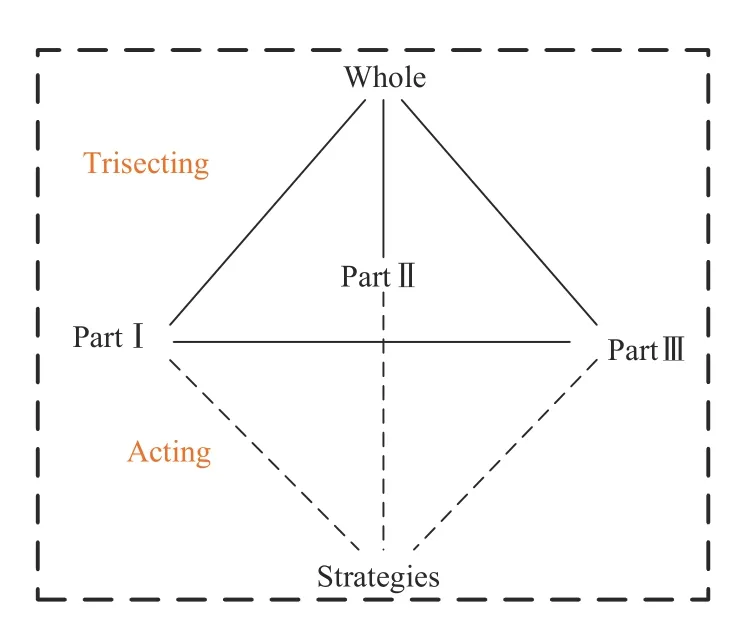
Fig.1.A trisecting-acting-outcome model.
B.Hesitant Fuzzy Sets
As one of the extended forms of fuzzy sets [20],HFSs were proposed by Torra and Narukawa [21],[22].Torra defined HFSs with the support of functions.The specific form is shown as follows.
Definition 1 [22]:Assume thatAis a crisp set,and then define an HFS onAby a functionh.When applied toA,it returns a map on [ 0,1].
Later,Xia and Xu [23] gave corresponding mathematical formulas to intuitively express HFSs.
Definition 2 [23]:The mathematical representation of an HFSHonAis shown as follows:
wherehH(a) denotes the set of all possible membership degrees in [0,1] wherea∈Abelongs toH.Moreover,hH(a) is called a hesitant fuzzy element (HFE),andHis the set of all HFEs.
A fter that,decision making problems with HF information[8],[24] have been gradually researched and developed.However,the time complexity of basic operations between HFEs proposed by Xia and Xu [23] is high,which is not convenient for solving practical problems.In response to this problem,Liaoet al.[25] made the following improvements to the basic operation rules.
Definition 3 [25]:For two HFEsh1andh2,and a real numbera,there are the following operations:
where represents thel-th elements of the HFE in an ascending or a descending order.
Similarly,Xia and Xu [23] defined the score function and the deviation function to determine the superiority relations between two HFEs.
Later,an HFIS that can reflect actual uncertainties was established,as shown in Table III.σ(l)

TABLE III HFISS
C.Two Theories of Behavioral Decision Making
PT and RT are two of the commonly used theories for BDM under uncertainties.
1) Prospect Theory:PT is an expected utility theory in the BDM theory that describes the psychological behaviors of DMs.How does PT characterize the psychological behaviors of DM s? This can be demonstrated via two classic psychological experiments.
Experiment 1:
A: You can definitely get wealtha.
B: You have a 50% chance of getting wealth 2a,and a 50%chance of getting nothing.
Experiment 2:
C: You can definitely lose wealthb.
D: You have a 50% chance of losing wealth 2b,and a 50%chance of losing nothing.
From the experimental results,it can be seen that for the first experiment,most DMs will choose A.For the second experiment,DM s will be more inclined to choose D.This result suggests that DMs are not blindly seeking to avoid risks.When facing with benefits,DM s are risk-averse.When facing with losses,DMs are risk-seeking.
In order to characterize this phenomenon,Kahneman and Tversky [12] established RT.In addition,the gain or loss values of the object are related to the selection of reference points.Moreover,DMs are more sensitive to loss states than gain states.Therefore,the value function can be represented by an asymmetric S-shaped curve,as shown in Fig.2.

Fig.2.The value function.
Afterwards,in order to accurately describe the value function of each result in different states relative to reference points,Tversky and Kahneman [26] proposed the mathematical expression of value functions.
where ∆O=O−Ordenotes the difference between the outcome valueOand the reference pointOr.If ∆O>0,it is a gain state,otherwise it is a loss state.Furthermore,αandβreflect the sensitivity of DMs in the face of gains and losses,respectively,where α,β ∈(0,1).Since DMs are more sensitive to losses,the loss aversion coefficient µ>1 is introduced in the loss state.
Another core content in PT is the weighting function.The realistic semantic explanations are that DMs often overestimate small probability events and underestimate high probability events.Thus,the graphic description of weighting functions is shown in Fig.3.
Afterwards,by psychological experiments,the mathematical expressions of weighting functions are determined as follows:among them,P+andP−represent the high probability or low probability values for an event,respectively.γandδare two risk parameters,which usually satisfy γ,δ ∈(0,1).With a large number of experiments,Tversky and Kahneman [26]believed that γ=0.69,δ=0.61 are more in line with the psychological behaviors of DM s in normal decision making processes.Since then,it has been recognized by a large number of scholars [27]–[29].

Fig.3.The weighting function.
According to the value function and weighting function,we can calculate the prospect value under different choices,and then,the DM chooses the object with the largest prospect value
2) Regret Theory:RT,as another content of the BDM theory,describes the impacts of regret and rejoicing on decision making results by comparing different options in advance.The theoretical framework of RT was constructed by Bell[13],Loomes and Sugden [30],and its main core contents are the utility function and the regret-rejoice function.
Each choice has a corresponding outcome value.The utility value for different outcome values can be calculated via using the utility function.Zhanget al.[31] effectively estimated the utility value under different outcomes with the support of power functions.
whereOdenotes the outcome value andνis a risk aversion coefficient,which satisfies ν ∈(0,1).It is determined by a DM’s ability to take risks.The fluctuations of the utility function under differentνvalues are shown in Fig.4.
Determining to characterize the regret and rejoicing of DMs is the main purpose of the regret-rejoice function.When the utility value of the selected object is greater than other objects,DM s will be delighted and the perceived utility value of the object will accordingly increase.Conversely,when the utility value of the selected object is smaller than other objects,DMs will feel regret,and the perceived utility value will decrease.
The following phenomena are observed in realistic psychological experiments: a DMis more sensitive to regret than rejoicing.In order to effectively reflect the reality,Penget al.[32] put forward a regret-rejoice function via an exponential formas follows:

Fig.4.The utility function.
whereκdenotes the regret aversion coefficient.The larger theμvalue,the more a DMis sensitive to regret.The fluctuations of the regret-rejoice function for differentμvalues are shown in Fig.5.
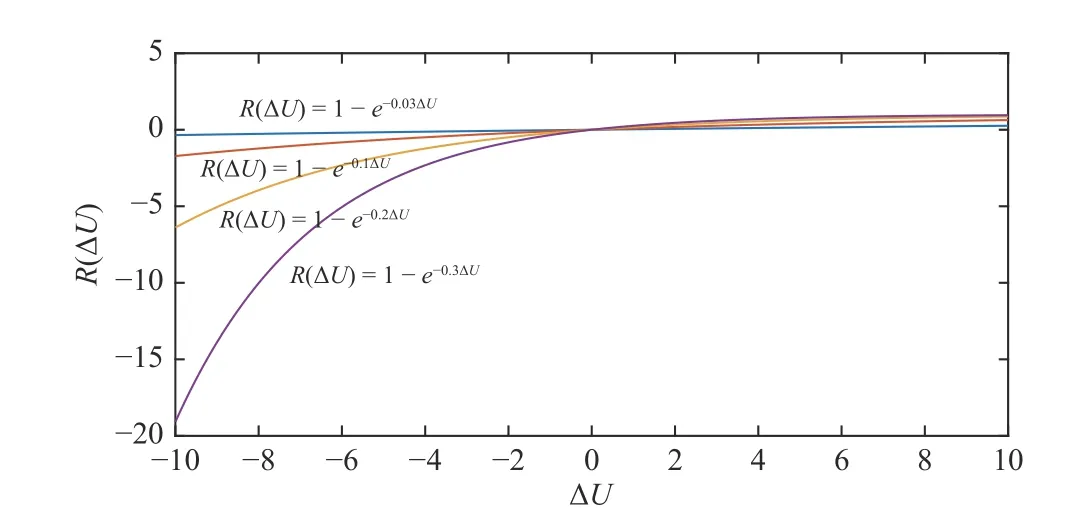
Fig.5.The regret-rejoice function.
By combining this with Fig.5,it can be concluded that a DM has the following conclusions on regret and rejoicing:
1) This regret-rejoice function is monotonically increasing.If ∆U>0,R>0,the current state is rejoicing.Conversely,when ∆U<0,R<0,it is a regret state.
2) The larger the regret aversion coefficientκis,the more sensitive the DMis to regret.This phenomenon can be seen from the figure: it can be seen from Fig.5 that with the increase ofκ,the curvature of the regret-rejoice function becomes larger,and the graphic presentation becomes steeper.
3) Psychological experiments show that a DM pays more attention to regret than to rejoicing.The graphic representation of this phenomenon is;compared with the rejoicing state,the regret-rejoice function figure in the regret state has a larger curvature and a steeper graph.
III.A HISTORICAL ACCOUNT OF THREE THEORIES
In order to establish a basis for reviewing recent advances,this section briefly summarizes the major results in the development of three theories of T-WD,HFSs and BDM.
In what follows,we first conduct a comprehensive descriptions for the above theories in terms of actual application needs,application scenarios,characteristics and constraints.The results are shown in Table IV.
A.The Development of Three-Way Decisions
In 2010,Yao [11] put forth the T-WD theory,which first provided an effective tool for the solution of uncertain decision making issues,and also reduced time and error costs for growing big data decision making issues.With huge advantages of T-WD models,it has attracted extensive discussions and research among scholars.The development context of the T-WD theory is shown in Fig.6.Up to now,T-WD has not only been limited to rough sets [33],but also applied to interval sets [34],shadowed sets [35],interval type-2 fuzzy sets[36],and so forth [37],[38].
In terms of theoretical expansions,Yao [18] put forth the three-way granular computing framework.Yao [39] studied three-way thinking,and designed a three-way conceptual model suitable for intelligent data analysis.Hu [40] built TWD spaces.Yao [41] explored set-theoretic models of T-WD.Furthermore,some scholars have used T-WD models to deal with problems in many fields,such as the evaluation of software projects [27],medical diagnosis in nephrology [42],and others.
In term of applications,three-way classification [43],three way processing [44],three-way concept analysis [45],three way learning [46],three-way conflict [3],[47],three-way clustering [48],and three-way recognition [49] have been successively investigated.At present,the T-WD theory has been developed into an effective method for independent information processing,and has important applications in image processing [50] and neural networks [51].
In term of applications,three-way classification [43],three way processing [44],three-way concept analysis [45],three way learning [46],three-way conflict [3],[47],three-way clustering [48],and three-way recognition [49] have been successively investigated.At present,the T-WD theory has been developed into an effective method for independent information processing,and has important applications in image processing [50] and neural networks [51].
In term of model improvements,considering the strict condition of equivalence classes,Zhanet al.[52] put forth a TWD model based on outranked classes,which avoids the application limitations of classic T-WD.Huanget al.[53]built a T-WD method with pre-order relations,which enriched the semantic interpretation of T-WD.Wanget al.[38] established a T-WD model with probabilistic dominance relations with intuitionistic fuzzy information,which provided a new method for solving intuitionistic fuzzy MADM problems.The developments of loss functions under classic T-WD model frameworks are summed up as follows: Jia and Liu [16] fully considered the wealth status of objects under different attributes and defined the concept of relative loss functions,which provided a new mechanism for objectively estimating the loss function value.In light of the above ideas,Liuet al.[54] applied relative loss functions into intuitionistic fuzzy environments.Considering the utility maximization,Zhanet al.[55] transformed a relative loss function into a relative utility function,which further enriched the decision making theory.In contrast,Liet al.[56] determined a pair of thresholds for the optimal division of objects from the evaluation functions and measures,reducing the subjectivity of determining the threshold by multiple loss function values.Gradually,DMs began to think about how to deal with objects in the three-way classification boundary domain,which led to the sequentialT-WD theory [57].Fromboth subjective and objective perspectives,Yanget al.[58] proposed a sequential T-WD model for decision making issues under dynamic mixed information.For the interpretability of recommendation results,Ye and Liu[59] established three sequential recommendation systems,which realized multi-level recommendation and reduced recommendation costs.Certainly,there are still many excellent achievements [60],[61] in the research on the T-WD model and its applications.The research results are almost studies on the classic T-WD model itself,which are a narrow scope of TWD models.Moreover,in the decision making model based on T-WD,there are few studies that consider the psychological behaviors of DM s.Therefore,the research of T-WD intelligent decision making models guided by the BDM theory is of practical significance.

TABLE IV COMPREHENSIVE DESCRIPTIONS
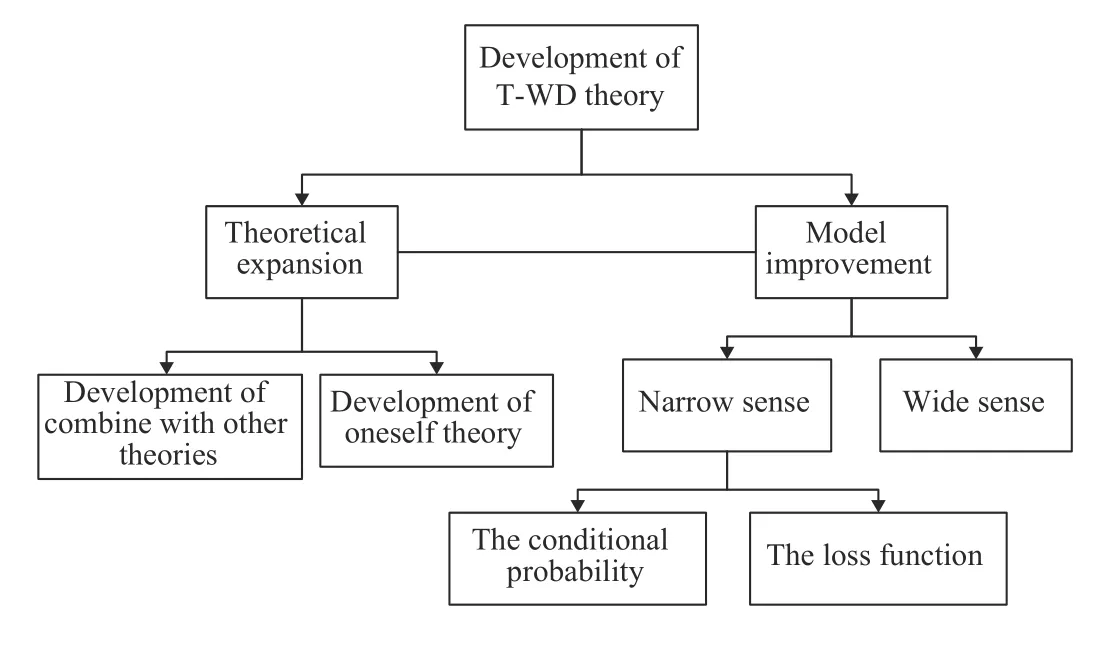
Fig.6.The development context of the T-WD theory.
Yao [18] began to discuss a wide sense of T-WD models in 2020.Recently,Yao [62] investigated a symbols-meaningvalue (SMV) space as a basis for a conceptual model of data science.This wide T-WD model is actually ternary thinking,i.e.,a whole part is divided into three reasonable parts,and adopts effective strategies to cope with each part,so as to obtain the desired effect.Given that the wide T-WD model is more flexible,practical and versatile,it has been accepted and studied by many scholars.Zhang [63] proposed a three-way C-means algorithm,which can efficiently implement the distribution of data points into clusters.The T-WD method based on multi-objective genetic algorithms researched by Zhanget al.[64] effectively solved the optimization and decision making problems of deep tumors.Liet al.[65] applied the classification idea of T-WD to the process of text classifications,and divided all texts into related texts,possible texts and irrelevant texts.After that,Yanget al.[66] solved the classification problem of dynamic texts by using the idea of sequential T-WD.In addition,it is noted that the Markov decision processes (MDP) is an important concept in artificial intelligence and a mathematical model of sequential decision making,which is often used to model reinforcement learning problems.By using dynamic programming and other methods,agent strategies that maximize returns are obtained,and it has been applied in automatic control [67],recommendation systems [68] and other topics.In view of the advantages of MDP,Caoet al.[69] used MDP to predict returns and risks in investments to obtain the expected utility of DMs;a Markovbased sequential T-WD intelligent decision making method is then established.Haoet al.[70] exploited an AE/OE concept lattice increment construction algorithmfor social networks in the dynamic forms context.Aimed at the decision making problem of auxiliary diagnosis of liver tumors under computer tomography (CT) images,Chenet al.[71] designed a classifier that can identify uncertain cases.With limited human-machine interactions,human-machine collaborative diagnosis can be achieved.On the basis of automatic classification of rules,uncertain cases will be submitted to doctors for further careful diagnosis.Imaging doctors only need to diagnose a very small number of CT images,which can achieve ideal accuracy and greatly reduce misdiagnosis rates.
In brief,existing research achievements of T-WD have greatly promoted the development of the T-WD theory from different perspectives and dimensions,and provided a kind of more effective paradigmfor solving decision making problems in various fields.Therefore,the future research on the intersection of the T-WD theory with mathematics,information and management disciplines is a promising and significant research direction.
B.The Development of Hesitant Fuzzy Sets
An HFIS is an information system with HF information.Therefore,this paper reviews the key milestones in the development of HFSs.
The HFS theory was proposed by Torra and Narukawa [21],[22] as the latest extended form of fuzzy sets to better describe actual indecision situations.In order to accurately describe its meaning,Xia and Xu [23] determined the mathematical expression of HFSs,which largely boosted the theoretical development and application research of HFSs.In recent years,HFSs have attracted extensive attention from many scholars.In the past ten years,HFSs have made revolutionary progress in both theory and application aspects.The development context of HFSs is shown in Fig.7.
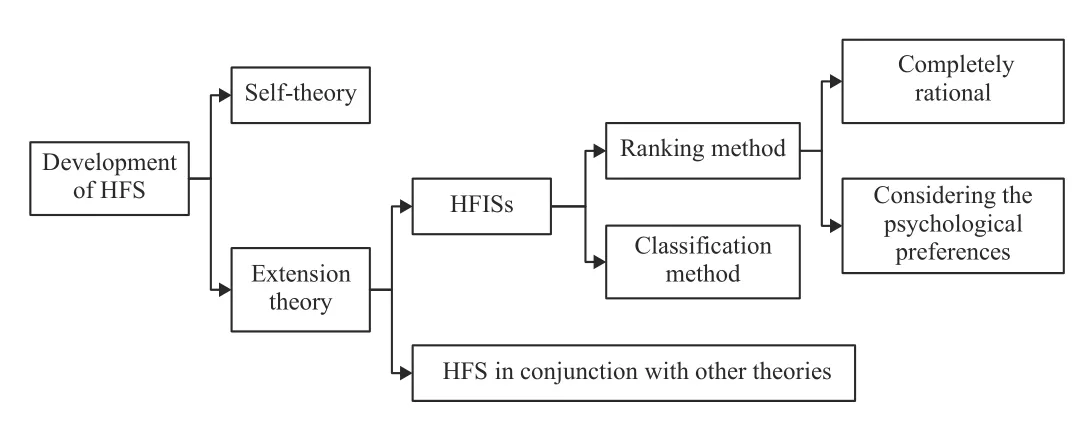
Fig.7.The development context of HFSs.
In theory,the research achievements are mainly divided into the self-theory and extension theory.The research findings of its own theory mainly include: HF integration operators [23],subtraction and division operations [72],distance measurements between HF information [73],HF clustering algorithms [23],HF preference relations [74],[75] and satisfaction degrees [76].The development of its extension theory is the combination of HFSs and other theoretical backgrounds,mainly including: Pythagorean HFSs [77],dual HFSs [78],interval-valued HFSs [79],[80],dual type-2 HFSs [81] and probabilistic HFSs [74],[82],[83].These theories lay a solid foundation of further development of HFSs.
In application,many HF decision making methods have been proposed.First,ranking methods include: the HFVIKOR method proposed by Liao and Xu [84],which determines the ranking result by calculating the closeness to the ideal solution.By simultaneously considering the relationship between the object and the positive and negative ideal solutions,the HF-TOPSIS method was put forward by Xu and Zhang [85].According to the strong outranking relations and weak outranking relations between objects,Chen and Xu [86]came up with the HF-ELECTRE II method.Later,by measuring the dominance degrees among objects,Mahmoudiet al.[9] introduced the HF-PROMETHEE method.Taking into account the uncertainty of DM s in evaluating options,Mishraet al.[87] developed an HF-additive ratio assessment method.There are many more ranking methods [88]−[90].However,it is not difficult to observe that the above ranking methods do not consider the subjective influence of DM s,i.e.,it is assumed that the decision making process is completely rational.This is obviously difficult to achieve in realistic decision making processes.
In recent years,some scholars have provided effective solutions for such problems.Considering the risk preference of DMs,Wanget al.[24] established a decision making approach with risk attitudes.Given the differing attitudes of DMs in the face of gains and losses,Zhouet al.[91] proposed a group decision making method based on PT.Renet al.[92] introduced a negative exponential function in PT to describe the psychological behaviors of DMs in HFISs,and obtained an HF prospect decision matrix according to the expectation level.In an HFIS,by analyzing the influence of regret and rejoicing on decision making results,Liuet al.[93]introduced satisfaction degrees under the framework of RT.In addition,many researchers [94] considered the influence of psychological behaviors on decision making processes and studied the BDM theory in HF decision making problems.Although the above methods take into account the impact of DMs’ psychological behaviors,and make up for the lack of complete rational assumptions in some ranking methods,the methods can only rank objects and can not determine the corresponding decision making results.
A fterwards,by combining the advantages of the T-WD theory in uncertain decision making,many scholars have continuously researched many HF T-WD methods that can obtain decision making results for objects.Lianget al.[7] established a risk strategy model on similarity classes under HFISs.Liang and Liu [95] put forward an HF T-WD model in HFISs.However,the model ignores the performance of an object itself,which leads to the same loss function value after different objects take actions.Obviously,this is not accurate.Wanget al.[96] proposed an HF state set under the framework of HF T-WD by starting from HFISs,and calculated the conditional probability of objects via an outranked class.In addition,each object has its own loss function value,which largely avoids the shortcomings of Liang and Liu’s method [95].Jiang and Hu [6] proposed the relative loss function from the perspective of the object’s evaluation value as its own wealth status,which reduced the deficiency of arbitrary determinations for loss functions in Wanget al.’s method [96].Likewise,there are many classification methods [2],[7],[24],[80]for objects in HFISs.
In summary,all existing HF T-WD models follow the risk minimization.However,DM s are not blindly pursuing risk minimization.Therefore,there is theoretical and practical value to establish a T-WD model guided by the BDM theory under HFISs.
C.The Development of Two Behavioral Decision Making Theories
The previous section shows the advantages of the T-WD theory in dealing with uncertain decision making issues,however the classic T-WD model has the following shortcomings:1) DMs always blindly pursue risk minimization;2) The model does not consider the influences of certain psychological behaviors of DMs on decision making results.In contrast,BDM theory is a theory that integrates behavioral science theories in psychology into finance,and discusses the decision making process from the perspective of organizational behaviors.It can better describe the influences of DMs’ psychological changes on decision making results.In the process of its vigorous development,many excellent results have emerged,where the main contents are PT and RT.The development context of PT and RT is shown in Fig.8.Therefore,we mainly introduce the development nodes of PT and RT as follows.
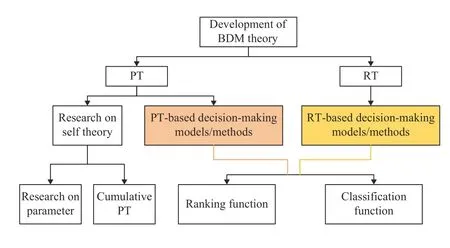
Fig.8.The development context of the BDM theory.
1) The Development of Prospect Theory:After a large number of experimental studies,some scholars concluded that many realistic decision making behaviors deviate from traditional decision making results,such as the deterministic utility [97].On the basis of summarizing the experimental results,Kahneman and Tversky [12] made a bold reform of traditional economics by applying psychology,revised the basic assumptions of traditional economics,and proposed PT [12]and cumulative PT [26] which can reflect the complexity and uncertainty of human decision making behaviors.
With the increasing number of actual uncertain decision making issues,PT has become the representative theory for analyzing BDM.PT has received increasing attention,and the research achievements of decision making guided by PT has increased.Among them,researchers have mainly focused on integrating PT into the analytical framework of traditional decision making theories.The improved decision making models [27],[28],[91],[92],[94] consider the influence of objects and backgrounds on decision making,and the subjective psychology of DMs.
There are many parameters involved in PT.Wu and Gonzalez [98] estimated parameter values via a series of preference experiments,and proposed a new weighting function.Gonzalez and Wu [99] introduced the concept of time values in PT,indicating the preferences of DM s for time.The reference point is more important content in PT,because it is crucial to consider whether the object belongs to the state of gain or loss,hence the selection of the reference point has the following categories.Selected as the positive and negative ideal solutions [100],aspiration levels [101],average values [91]and the positive ideal solution [94] as reference points.It is not difficult to observe that the above reference points [91],[94],[100],[101] are a specific point given by a DM.These methods [91],[94],[100],[101] not only have a certain subjective preference,but also ignore the psychological behaviors of gains and losses brought by the comparison among objects.In a decision making process,a DM usually compares the selected object with other objects in pairs,which is a common behavior.Tianet al.[29] regarded all objects as reference points in the framework of PT under probabilistic HF environments,which effectively avoids the above-mentioned deficiencies of reference points.For the decision making problem of vehicle safety performance evaluation with probabilistic HF information,Lianget al.[94] introduced a multiattribute group decision making model based on PT under HF information.Leoneti and Gomes [102] proposed a new TODIM method based on the value function in PT,which has low complexity and high predictive ability.Wanget al.[101]put forward a group decision making method based on PT under a linguistic environment,which solved the decision making problem of supplier selections.For the risk assessment problem of renewable energy investments with intuitionistic information,Ilbaharet al.[103] improved the failure model based on PT.Xueet al.[104] solved the HF linguistic matrix game problems for MADM with PT.
The above research results based on PT can only can rank objects,and cannot provide decision making results.Considering that PT can only describe behaviors of DMs but not make decisions,Wanget al.[27] established a T-WD model based on PT.Although it is inappropriate for different objects to have the same outcome matrix in this model [27],it can reduce the decision cost for big data decision making problems in a certain extent.Zhonget al.[105] established a TWD model based on PT by considering both time outcomes and monetary outcomes in PT,and solved multi-objective decision making problems.
Therefore,it is easy to observe that the research on the TWD model guided by PT under HFISs has not been perfected.That is,there is still insufficient research on DM s’ psychological behaviors in the face of gains or losses for decision making results under HFISs.
2) The Development of Regret Theory:PT describes risk attitudes of DMs in the face of gains and losses.Another research result in BDM theory,RT describes the influences of DMs’ regret and rejoicing on decision making results.Based on this phenomenon,Bell [13] and Loomes and Sugden [30]proposed RT to measured the DMs’ propensity by modifying the utility function.RT has fewer parameters than PT,and does not require consideration of subjective probability factors and reference points.Therefore,in combination with decision making theories,RT is more advantageous than PT.
RT has been widely developed and applied due to its advantages in describing a DM’s expected reactions to future outcomes of events.For instance,Herweg and Müller [106]explored the relations between salience theory and RT,proving that the salience theory is a special RT.Lianget al.[94]proposed the gained and lost dominance score method based on RT in probabilistic interval-valued HF environments to solve the supplier selection problem of epidemic prevention products.Linet al.[107] addressed HF multi-attribute matching problems under the guidance of RT.Tianet al.[108]established a consensus decision making model via RT under a probabilistic linguistic environment.Wanget al.[109] combined the projection model with RT to provide a new method for interval type-2 fuzzy decision making problems.These methods [94],[107]–[109] only have the ranking function and do not have the classification decision making function.However,in practical decisions involving a large number of objects,DM s pay more attention to the classification decision results of objects.Later,under an interval type-2 fuzzy situation,Wanget al.[36] analyzed the utility values of objects under different actions,selected the maximum utility value regarded as a comparison object,and finally chose the action with the larger perceived utility value.Wanget al.[36] was used the combination of RT with T-WD for the first time,which not only enriched the T-WD,but also promoted the development of RT.However,the outcome matrix of objects in Wanget al.method [36] is determined by the subjective experience of DMs,where there is a certain degree of randomness.In addition,the maximumutility value is chosen as a comparison object,which completely ignores the influence of rejoicing on decision making results.Moreover,Zhuet al.[110] put forth the relative regret and rejoicing matrix via scoring functions according to the evaluation information and selected a global comparison object.However,in Zhuet al.method [110],the regret and rejoicing matrixes of object under the conditional attribute are always zero at the same time,which contradicts the actual situation.In addition,the best results of Zhuet al.method [110] under different risk strategies are different,which reveals the instability of the method.Further,[111] investigated a three-way MADM method via RT and its application to medical data under fuzzy environments.
In conclusion,the research of RT in uncertain decision making is still insufficient,which needs continuous development.
In view of the advantages of the BDM theory in describing the psychological behaviors of DMs,the development of TWD models has ushered in a new opportunity.That is,the TWD model guided by BDM theory can better reflect realistic decision making processes.
An HFIS is a kind of common uncertain information expression.Thus,determining how to reasonably describe the decision making process and establish an effective decision making model to solve the actual problem is a subject of practical significance.There are many excellent results of T-WD models under HFISs.There is also research on BDM theory in HFISs.However,the development of TW-BDM methods under HFISs is not perfect.
Due to the special uncertainty of HFISs,Liuet al.[93] used a distance formula to measure the utility difference of two objects.Although this is a solution,this approach will lose the original hesitant ambiguity and uncertainty.Therefore,the research on RT in HF environments still needs to be perfected.Wanget al.[112] improved the regret-rejoice function by using the Taylor expansion,which can satisfy properties of classic functions and retain the original uncertainty.Furthermore,the above methods can finally get the ranking result for objects.There exist some classification models guided by RT.Wanget al.[112] established a T-WD model via RT in HFISs.The model can not only reflect actual uncertainties,but also consider regret and rejoicing in the decision making process.This model provides a new idea for the research on the BDM theory under HFISs,and also expands the research scope of RT.In addition,the decision making model of DMs’risk preferences in the face of gains or losses has not been studied in HFISs.
IV.BIBLIOMETRIC ANALYSIS
In order to understand the development of PT,RT,T-WD,and HF more intuitively,this section conducts a bibliometric analysis for related know ledge.In particular,it is analyzed from the following three aspects:
1) Annual total number of retrievals;
2) Distribution of major article types;
3) Distribution of subject areas.
In addition,web of science (WOS)1http://webofscience.com/is a large-scale comprehensive,multi-disciplinary,core journal citation index database,including the three major citation databases SCI,SSCI,A&HCI.It contains more than 13 000 authoritative,highimpact academic journals from around the world,covering the fields of natural sciences,engineering technology,biomedicine,social sciences,arts and humanities.In summary,the WOS is an important database for obtaining global academic information.Therefore,this paper uses the WOS database for bibliometric analysis.
A.Total Number of Retrievals
PT and RT scientifically describe the influences of DMs’uncertain psychological behaviors on decision making result from the perspective of psychology.In addition,HFISs can truly reflect the hesitation and uncertainty of realistic decision making processes.Furthermore,T-WD is an effective tool for dealing with uncertain decision making problems.It has an important influence on the basic theory of artificial intelligence,computer and management applications.In view of the advantages of the above theories,they have received extensive attention from scholars since being proposed to the present.
As of August 2022,in the Web of Science,the total number of retrievals for PT,RT,T-WD and HF are: 30 274,2483,1423 and 2146,respectively.Fig.9 shows the total number of retrievals per year for PT,RT,T-WD and HF from 2012 to 2019.As can be seen from Fig.9,the four theories all show an overall upward trend.By combining with the total number of retrievals,this further verifies that PT,RT,T-WD and HF are nowadays research hotspots.
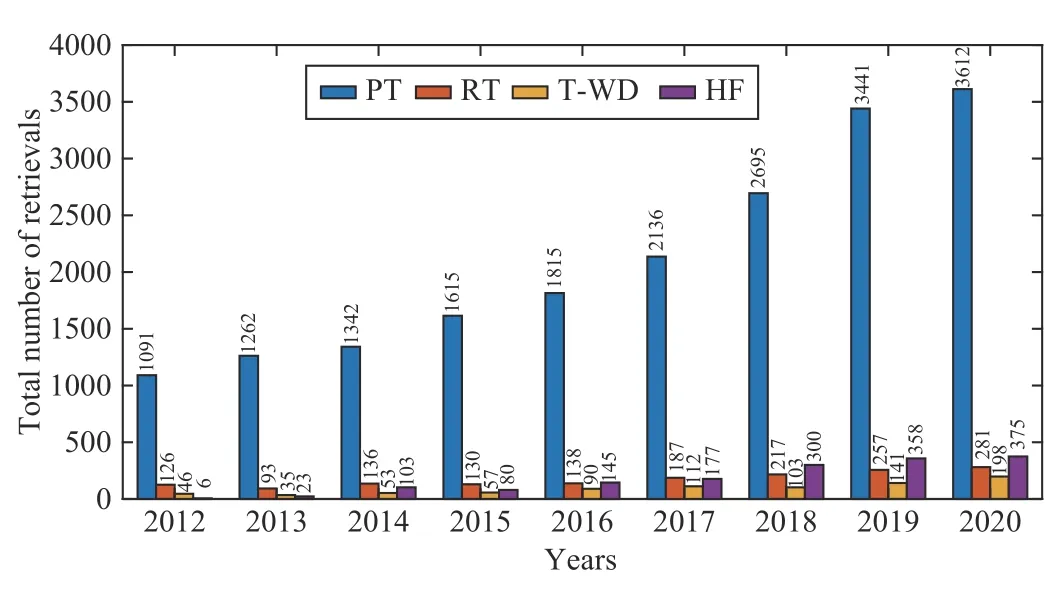
Fig.9.Annual total number of retrievals in the WOS.
B.Major Article Types
In this section,we make statistics on the types of articles mainly involved for PT,RT,T-WD,and HF.The distribution of the main article types of PT,RT,T-WD and HF in WOS is shown in Table V.From Table V,we can see that among the articles with the theme of PT,RT,T-WD,and HF,there are the most research articles.Research articles are articles that contribute to theoretical or basic research.The report is novel and has complete research results.The innovation determines the academic value of subject research.Thus,Table V reveals the value of academic research on PT,RT,T-WD and HF.

TABLE V DISTRIBUTION OF MAJOR ARTICLE TYPES IN THE WOS
C.Distribution of Subject Areas
The previous section confirmed the academic value of PT,RT,T-WD,and HF.However,decision making models are built to solve decision making problems.Therefore,this section counts the application value of PT,RT,T-WD,and HF.
In the WOS,the distribution of subject areas of PT,RT,TWD,and HF applications are shown in Fig.10.

Fig.10.Subject area distribution of PT,RT,T-WD,HF in the WOS.
As can be seen from Fig.10,the applications of PT,RT,TWD,and HF mainly involve 10 specific fields respectively,i.e.,the application scopes of PT include mathematics,geochemistry geophysics,physical sciences other topics,engineering,physics,business economics,computer science,geography geology,environmental sciences ecology.Moreover,from the proportion of each field in Fig.10,the application scopes of PT,RT,T-WD and HF are wide.Therefore,this conclusion shows the great application value of PT,RT,T-WD and HF.
V.ADVANCES IN THE CURRENT RESEARCH
Just like the continuous development of society and the continuous progress of science and technology,existing research results are not perfect and static,it is a process of discovering problems,solving problems,and constantly improving.In what follows,we first analyze in detail the contributions and deficiencies of several existing decision making models based on the BDM theory.Then,the differences among these methods are discussed.
A.Diverse Types of Decision Making Models
Wang and Wang [101] first expressed the linguistic termset model by stochastic analysis via using a complete probability distribution,and then,the expected values and associated expected probabilities are expressed by a binary expectation form.Finally,an MADM model on a stochastic linguistic termset by aggregation of prospect and weight functions is proposed.The specific calculation process of this model is shown in Algorithm1.Assuming that there arenobjects,mconditional attributes,andqexperts in an actual decision problem,the time complexity of Algorithm1 is O(nmq) and the space complexity is S(6mnq+7mn+2m).However,the drawback of this model is also clear where this 2-tuple aspiration is a very subjective factor,which is influenced by DMs.The randomness 2-tuple aspirations may lead to unstable decision making models.Additionally,Wang and Wang’s method[101] does not implement classification results for objects.In particular,when decision making issues involve more objects,the time cost of this method will be larger.
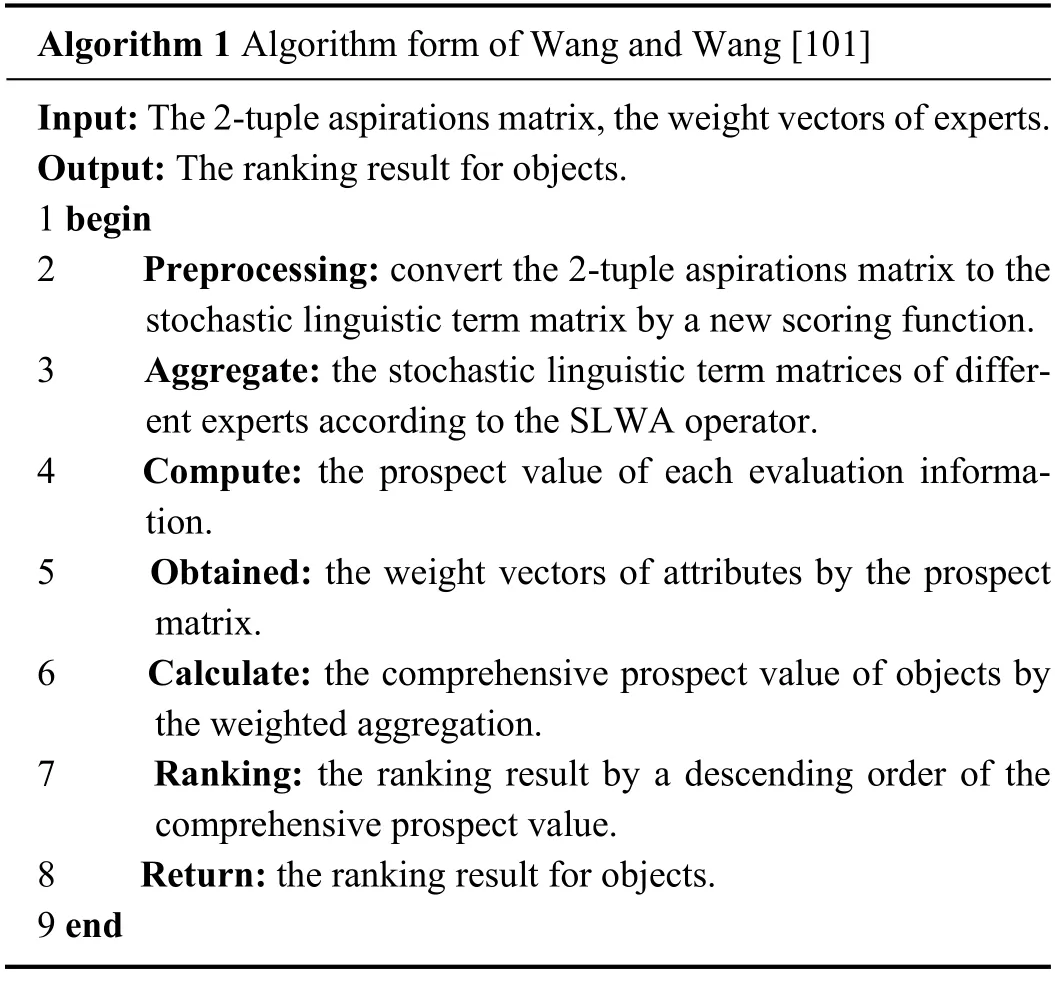
Zhouet al.[91] used the scoring function and deviation function of HFEs to describe the profit and loss in an investment problem,which considered the group decision making method of the consensus reaching process for solving the portfolio selection problem.In the research on PT under HFISs,a new HF prospect value function was proposed,which truly reflected actual uncertain information.On this basis,a consensus decision making model based on PT was established,which not only considered group intelligence on the consensus process,but also provided a new method for settling practical group decision making issues.The specific decision making process of this method is shown in Algorithm2.Assuming that there arenobjects,mconditional attributes,andqexperts in an actual decision problem,the time complexity of Algorithm2 is O(q2mn) and the space complexity is S(4mnq+mn+n).However,Algorithm 2 also shows that this method can only select the object with the largest return or the least risk in the end,and the ranking and decision making results of other objects are unknown.This limits the application scope of the method.In addition,due to the particularity of HF environments,the algorithmhas high complexity in the feedback process and the calculation of the HF prospect value is not conducive to solving the decision making issue under the actual big data background.
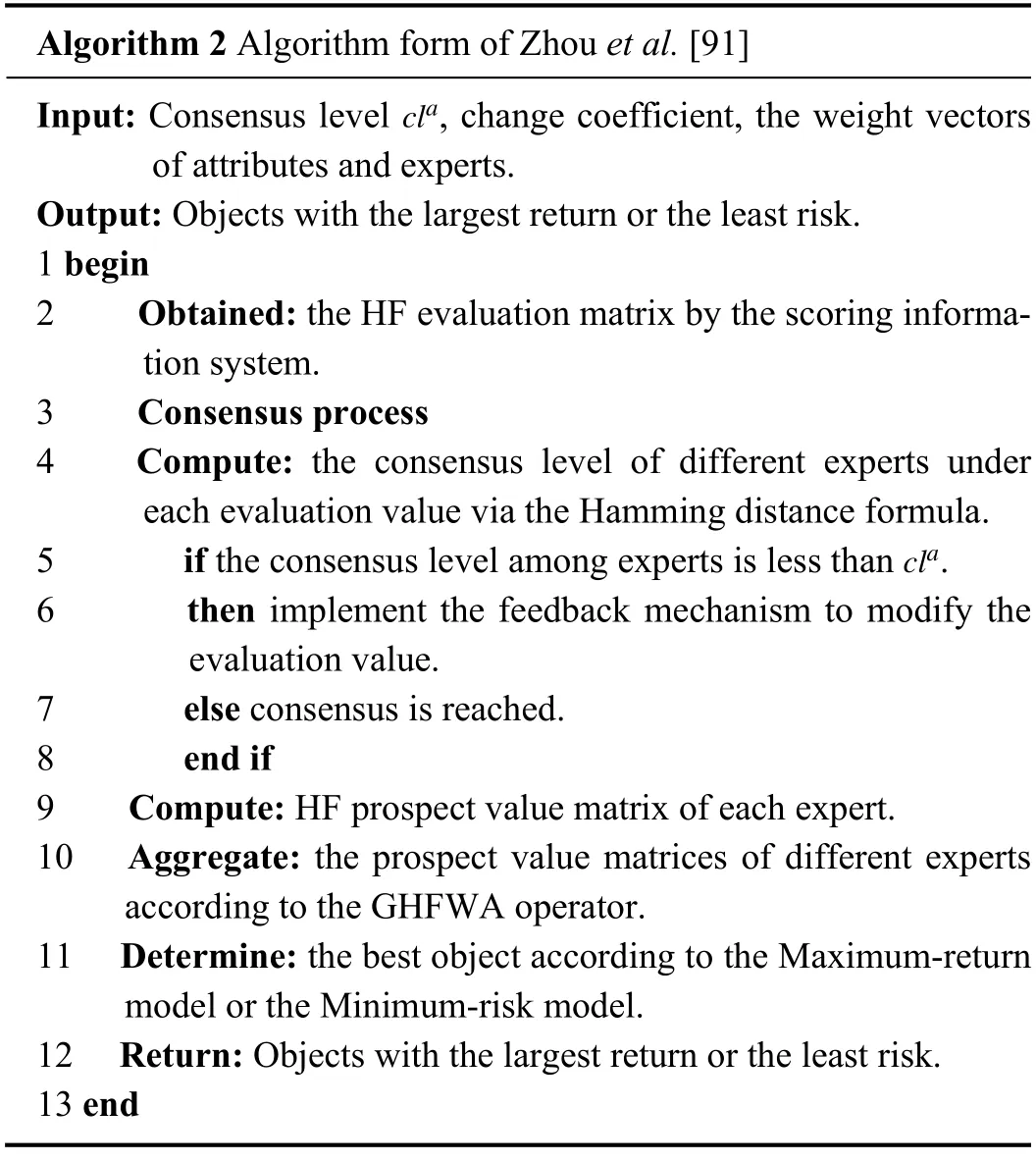
Liuet al.[113] proposed a T-WD group MADM method,which considered the DM’s psychological behaviors when making decisions in uncertain domains.This method divides the objects into three regions according to a critical value,which simplifies the computational complexity of three divisions.Finally,the method proposes a way on how to select the topKobjects from the three domains.The main computational process of the proposed method by Liuet al.[113] is shown in Algorithm3.Assuming that there arenobjects,qexperts,and the number of objects in the positive and negative regions isK1andK2in an actual decision problem,the time complexity of Algorithm3 is max(O(K1q),O((n−K1−K2)q)) and the space complexity is max(S(nq+2K1q+2n+K1+4),S(nq+2n+4+2(n−K1−K2)q+(n−K1−K2))).However,this method has the following deficiencies:
1) This method implements a ranking of objects in the uncertainty domain according to the weighted prospect values.However,this method does not consider the weighted prospect values of all objects to get the complete ranking result,and only obtains the ranking result of some objects.Thinking from another angle,if the complete ranking result of all objects can be obtained,DMs can achieve the goal by selecting the topKobjects.
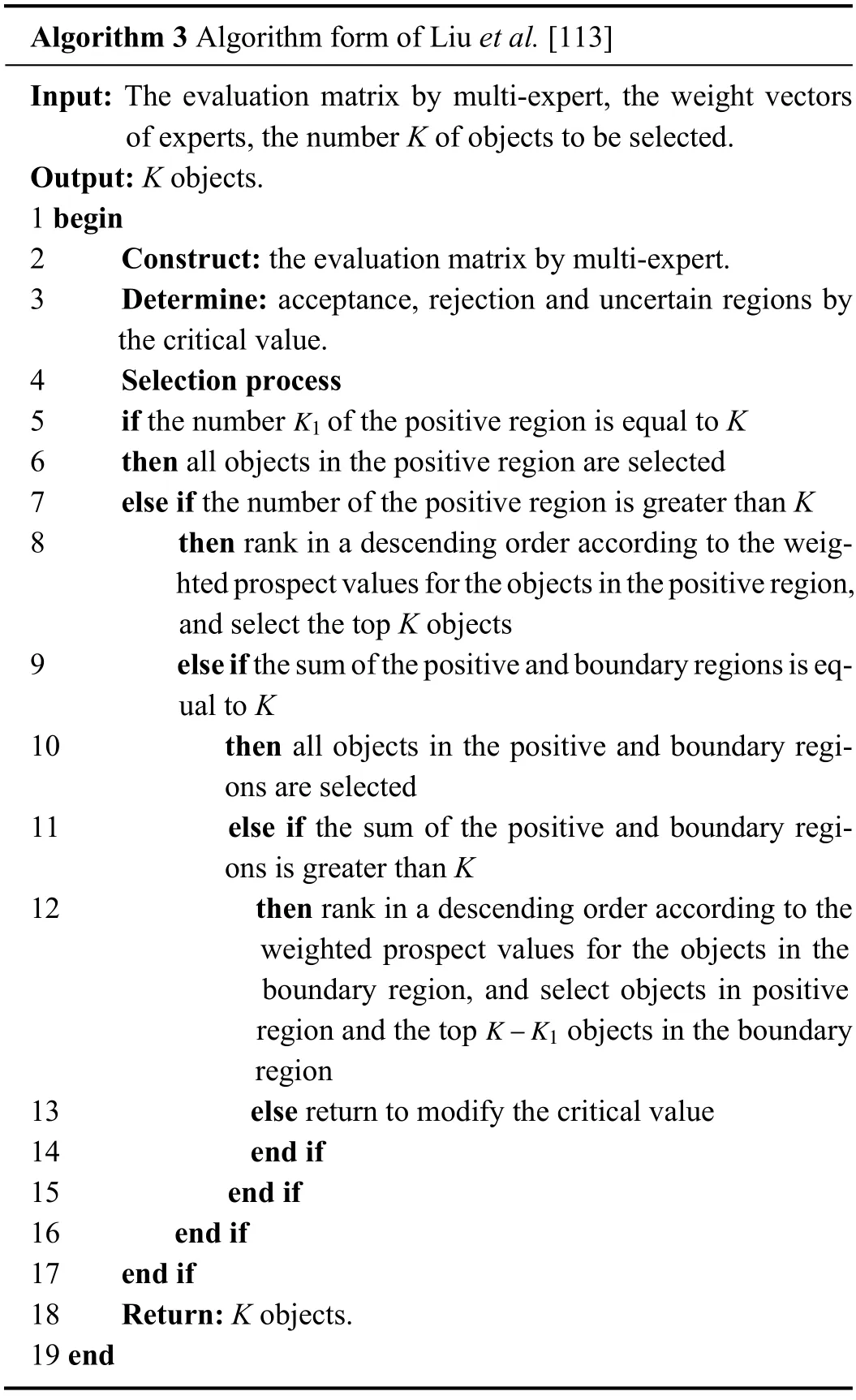
2) In the three-way group decision making method of Liuet al.[113],the evaluation matrix is given by multiple experts.However,the information evaluation of each object is too one sided without considering multiple levels.Most of the realistic decision making problems are MADM problems.Therefore,it is worth thinking about whether the three-way group decision making method [113] can be further improved.
3) The introduction of critical points reduces the time complexity of the method,but determining how to choose an appropriate critical value is not.Usually,the number of objects in different domains is uncertain in the problem,thus the setting of the critical value also makes the method not stable enough.In an actual division-making process,there are often cases where the positive and negative domains or the boundary domain are empty,and the division rules need to be continuously adjusted to obtain the optimal decision result.Therefore,we need to discuss the above issues further.
Wanget al.[27] used the value function in PT instead of the loss function in the T-WD model,and then determined the classification rule based on the principle of maximizing the prospect value.The proposed model by Wanget al.[27]makes up for the deficiency of the classic T-WD model blindly pursuing the minimum risk,and also describes the risk attitudes of DMs.The specific algorithmis shown in Algorithm4.Assuming that there arenobjects andqexperts in an actual decision problem;the time complexity of Algorithm4 is then O(nq) and the space complexity is S(n+q+23).However,Wanget al.[27] only gives a new semantic interpretation of T-WD from another perspective,and the subjectivity of two core problems in T-WD,the loss function and conditional probability,are not eliminated.What is more,Wanget al.’s extended T-WD model increases a parameter and its uncertainty further increases.Furthermore,in this model,because the properties of the objects themselves are ignored,different objects have the same result matrix,which is not practical.Thus,Wanget al.provides new ideas for the application of PT to uncertain decision making,but the model can be improved to better reflect actual situations.
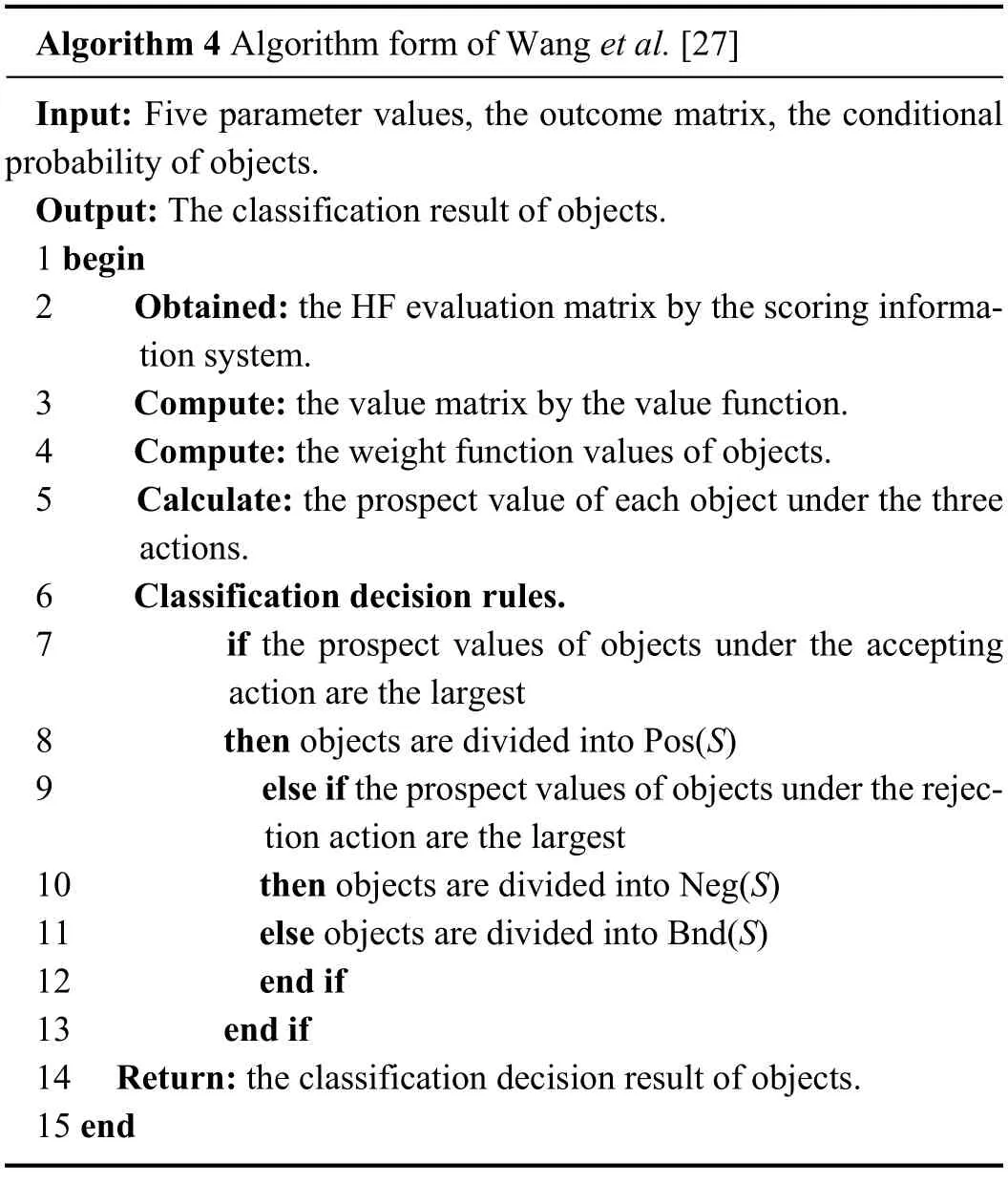
In addition,Wanget al.[114] developed a new TW-BDM model based on cumulative PT.First,the value function in PT is used to describe the different risk preferences of DMs for gains and losses.Second,the nonlinear transformation of conditional probabilities is portrayed via using the weighting function.Finally,the cumulative decision weights are determined by considering the increasing order of the value function.Based on this,a new T-WD rule is derived by combining the value function and the weighting function with the principle of maximizing the cumulative prospect value.The specific algorithmis shown in Algorithm5.Assuming that there arenobjects,qexperts in an actual decision problem,the time complexity of Algorithm5 is O(6q+2n) and the space complexity is S(4n+7q+6).Likewise,the deficiencies of outcome matrices and conditional probabilities of objects are similar to Wanget al.’s model [27].

Tianet al.[108] considered regret and rejoicing psychological behaviors in modeling process of multi-expert multiattribute consensus decision making problems with probabilistic linguistic information.The volatility degrees of regretrejoice values are used to calculate the consensus level among experts.In addition,the probability value of each possible state is reasonably developed via using the Dempster-Shafer theory.Finally,the ranking of objects is realized by a descending order of the overall perceived utility value of the objects.The specific decision making process of the model is shown in Algorithm6.Assuming that there arenobjects,mconditional attributes,qexperts,andgstatus in an actual decision problem,the time complexity of Algorithm6 is O(n2mqg) and the space complexity is S(n2mqg+nmqg+2nm+g+q+n).However,when calculating the perceived utility value,Tianet al.[108] adopted a transformation function to convert the probabilistic linguistic terminto an exact number,which cannot correctly reflect actual uncertainties.Moreover,the loop iteration of the modified information to reach consensus may lead to high computational complexity in the process of modifying the evaluation information.
Due to the lack of cognitive information,the extended gray numbers can better express actual uncertainties.In the research on RT in the context of gray numbers,Zhouet al.[115] constructed a new utility function,the regret-rejoice function and the overall perceived utility function in view of the uncertainty of gray numbers.In addition,for the stochastic MADM problemunder interval probability information,Zhouet al.[115] proposed a method based on RT and the TOPSIS method to realize the ranking for objects,which expanded the research scope of RT.The specific steps of this method in solving practical problems are shown in Algorithm7.Assuming that there arenobjects,mconditional attributes in an actual decision problem,the time complexity of Algorithm7 is O(nm) and the space complexity is S(5mn+m+5).In this method,the absolute ideal point is selected in the calculation of the regret-rejoice value,and the objects are all regretful emotions,which ignores the influence of rejoicing on decision making results.In addition,it is obvious that this method only has ranking results,whether the object is right or wrong.This method does not give specific decision making results,and it is inconvenient to solve decision making issues in the context of big data.
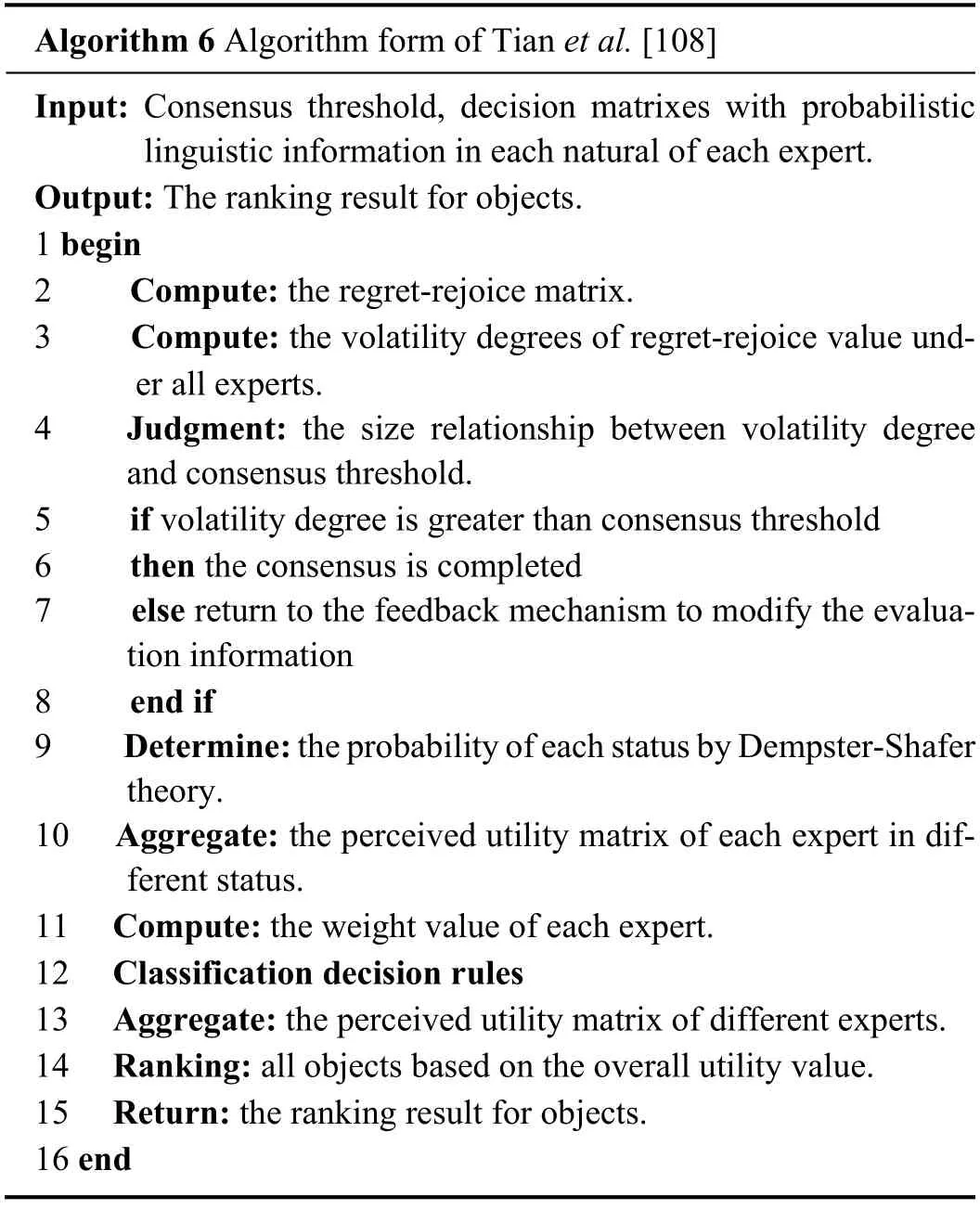
In order to cope with risks and uncertainties,Wanget al.[36] used RT and interval type-2 fuzzy sets to improve T-WD models in coping with uncertainties,and constructed a RTbased T-WD model under an interval type-2 fuzzy information.First,the interval type-2 fuzzy outcome matrix is constructed via the regret-rejoice function.Meanwhile,Wanget al.[36] estimated the conditional probability via using the relative closeness of the TOPSIS method.Finally,the tri-partition rules are derived from the expected utility maximization perspective.The specific calculation steps of this model are listed in Algorithm8.Assuming that there arenobjects,mconditional attributes andqexperts in an actual decision problem,the time complexity of Algorithm8 is O(nmq) and the space complexity is S(nmq+3nq+8q).In addition,from Algorithm8,we know: the construction of the outcome matrix is highly subjective,which brings instability to the decision making result of the designed model.It is obviously not practical for different objects to have the same result matrix.This model selects the object with the largest outcome value as the comparison object,so that each object’s rejoicing value is 0,which is too one-sided.In addition,the type of data for the evaluation value limits the application of this model to some extent.
Algorithm7Algorithm form of Zhouet al.[115]
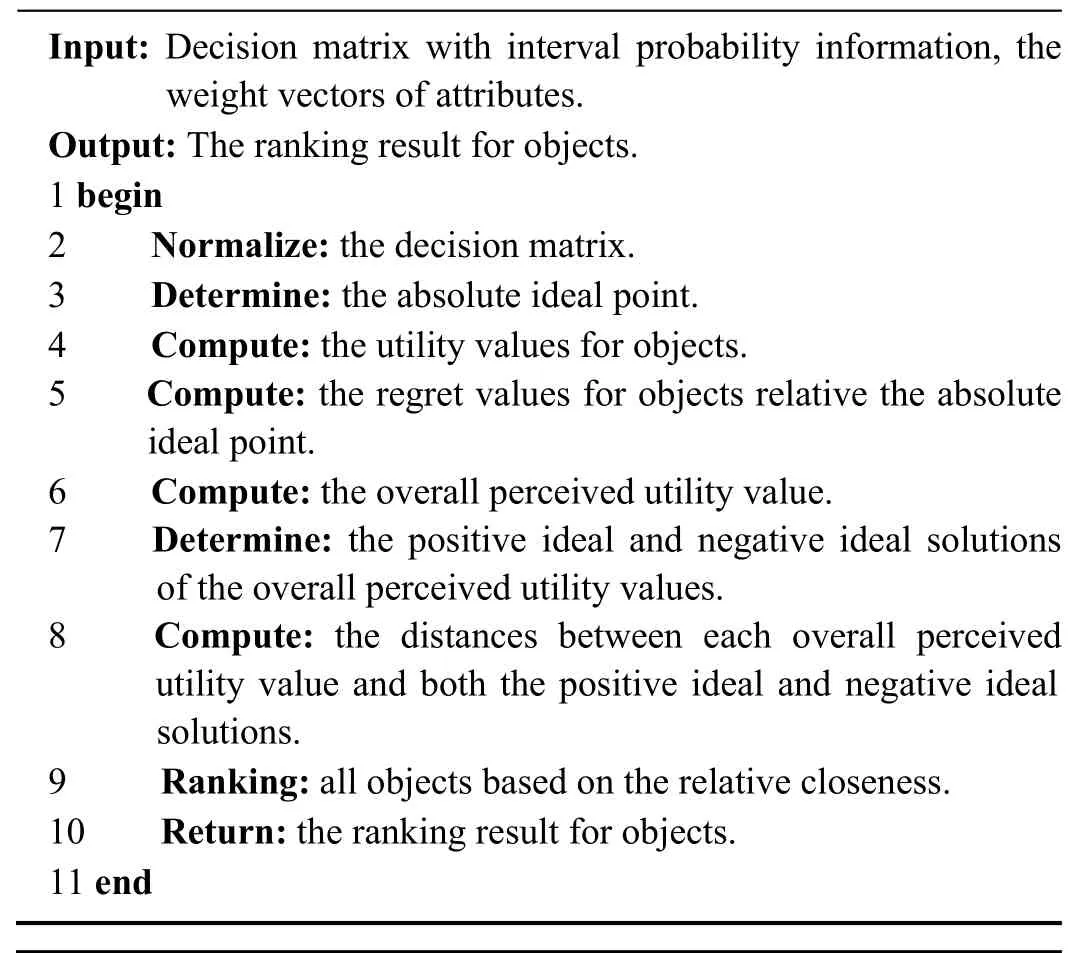
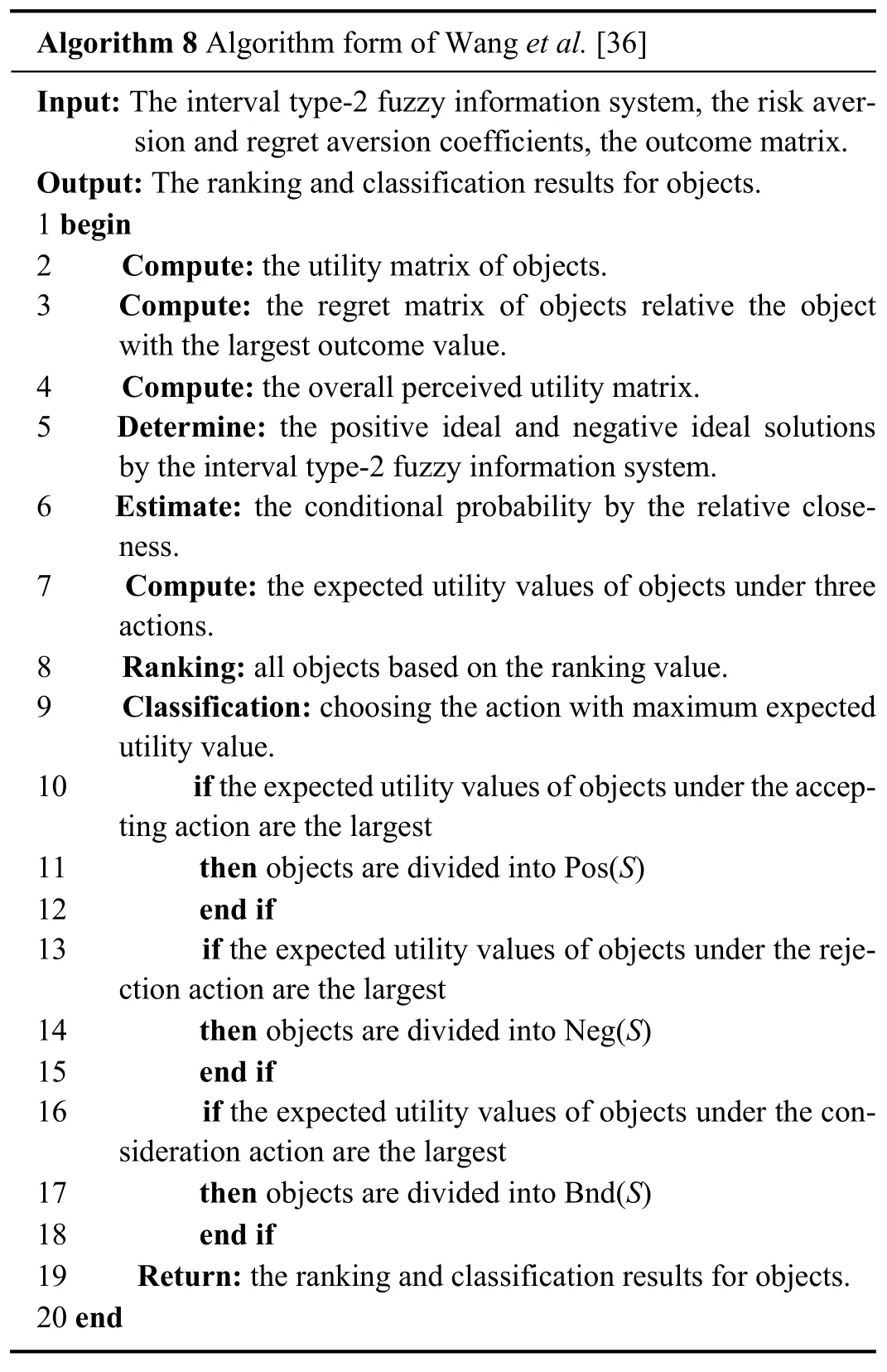
RT is a psychological behavior that depicts the emotions of DMs after comparing the current choice with other choices.Due to the influences of regret and rejoicing psychologies,DMs tend to make irrational decisions when faced with uncertain decision risks.Lianget al.[2] introduced RT into TWD with decision-theoretic rough sets to describe the influences of psychological behaviors on risky decision making behaviors.Furthermore,In order to meet the actual needs of DM s in resource allocation,Lianget al.[2] established two adjustment objectives from the perspectives of minimizing the utility loss and maximizing the utility of the positive region.The specific process is shown in Algorithm9.Assuming that there arenobjects in an actual decision problem,the time complexity of Algorithm9 is O(6n) and the space complexity is S(35n).However,the outcome matrix for objects in this model are estimated via using Liang and Liu’s loss matrix[116],which do not conform to realistic semantic meaning.In addition,in this method,the interval-valued loss function values of each object in different domains are determined subjectively.Therefore,this method is easily affected by subjective factors.
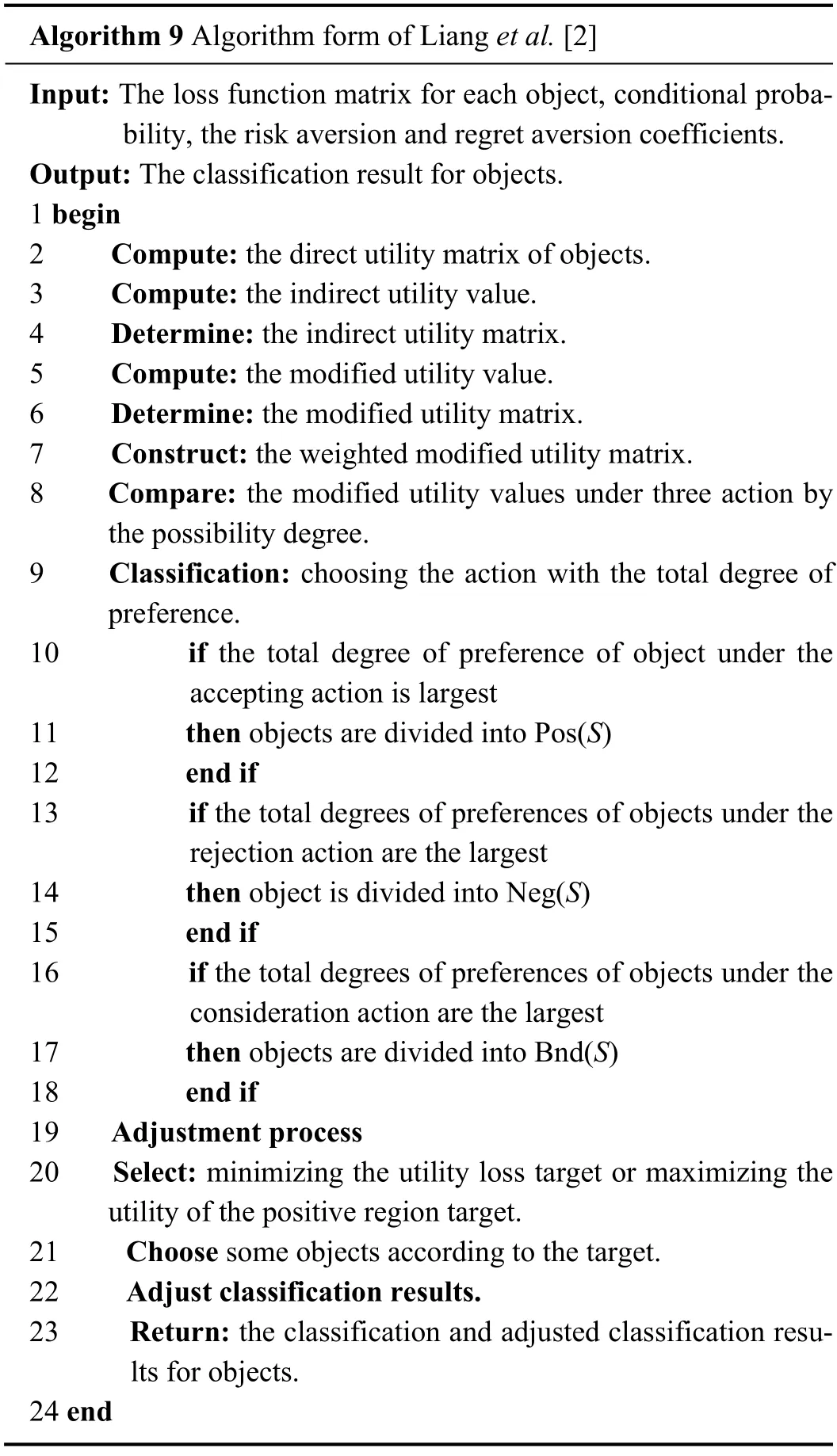
In order to solve the new energy investment risk assessment problem with Z-number information,Penget al.[32]combined Z-numbers,and RT with the ELECTRE III method to build an applicable decision support model.The Z-number qualitatively describes the uncertainty information in the investment process.RT is used to truly reflect the psychological behaviors in the decision making process.The ELECTRE III method integrates the evaluation information under each attribute and calculates the sorting index to achieve the assignment result for objects.The pseudocode form of the model is shown in Algorithm10.Assuming that there arenobjects,mconditional attributes in an actual decision problem,the time complexity of Algorithm10 is O (n2m) and the space complexity is S(2n2m+3n2+3m2+4mn+3m).This model proposes a new classification idea,which is more objective in decision making results than the classic T-WD model;but,this model cannot directly settle decision making issues under other uncertain information systems.

B.Discussions
The achievements in the decision making theory are endless,but only 10 decision making methods based on the BDM theory have been analyzed in detail above.Each method has contributed to the development of decision making theory and is worthy of serious study and consideration.In order to clearly show the general differences among the methods,we discuss the differences among the above ten methods from four aspects.

TABLE VI DIFFERENCES AMONG DIFFERENT METHODS
Table VI shows the differences among the above ten decision making methods in terms of background,psychological behaviors,ranking and classification.As can be seen from Table VI.
1) Various BDM models have been applied to many background information,such as HF information,stochastic linguistic information,and so forth.
2) Most BDM models are unable to simultaneously rank and categorize for objects e.g.,Wang and Wang [101] method,Zhouet al.[91] method,Wanget al.[27] model,Wanget al.[114] model,Tianet al.[108] model,Zhouet al.[115]method and Lianget al.[2] model.
3) Moreover,Zhouet al.[91] method is based on PT under HFIS.Wanget al.[27] model,Wanget al.[114] model,Wanget al.[36] model and Lianget al.[2] model are based on TW-BDM.Thus,the research on the TW-BDM methods under HFISs is not perfect.
In order to more intuitively demonstrate the advantages and limitations of the above methods,we summarize and show them in Table VII.It can be seen from Table VII that various decision making methods in different application backgrounds still have shortcomings.Therefore,this vacancy is a subject worthy of further study.
VI.CHALLENGES AND FUTURE OPPORTUNITIES
The above section has demonstrated existing research achievements,but also listed some shortcomings.In what follows,we propose several feasible feasible research topics and discuss some research challenges.
A.The Research on Three-Way Behavioral Decision Making Methods in Incomplete Hesitant Fuzzy Information Systems
An HFIS is one of the expressions of daily uncertain information systems.In addition,in the face of the explosive grow th of data in a realistic decision making process,data may be missing and omitted.Therefore,the research on the decision making method or model for an incomplete HFIS has certain practical value.In addition,HF information and incomplete information [88] indicate uncertainty in the decision making context.In view of the advantages of T-WD models and the BDM theory in dealing with uncertain decision making problems with incomplete HF information,it is worth further researching the T-WD model guided by the BDM theory under an incomplete HFIS.
In addition,considering the different risk preferences of psychological behaviors of DMs in the face of gain or loss in an incomplete HFIS,that is,establishing a T-WD model guided by PT,and the main challenges are:
1) Handling incomplete data is the first step in building a model or solving a problem.The completion method [117]and model extension method [55] are the common methods for dealing with incomplete data under real-value information systems.However,we must determine whether existing solutions have advantages in handing HF information.Thus,determining how to deal with incomplete data in HFISs is the first question to be explored.The solution of this problem can provide a new paradigm for dealing with incomplete HF decision making problems,which has certain application values.
2) In real-valued incomplete information systems [55],the similarity relation is usually used to measure the relationship between objects.Due to the particularity of HFISs,it is too strict to directly apply the similarity relation,which will lead to unsolved practical problems.Therefore,it is worth thinking about how to define new binary relations in an HFIS with incomplete information.The new binary relation can provide a theoretical basis for solving uncertain decision making problems with incomplete HF information.
3) An incomplete HFIS [88] reflects the uncertainty of the decision making process.For uncertainty problems,DM s’psychological behaviors affect the decision making results.It is of practical significance to study the psychological behaviors of risk preference in the decision making process under incomplete HFISs.That is,the model based on PT is studied in an incomplete HFIS.In the PT framework,the reference point determines whether the object is a gain or loss state.Hence,for the HFIS with missing data,determining how to choose a reasonable reference point is one of the challenges.This provides intelligent support for the application of PT in incomplete HFISs.
4) Subsequently,the core contents in PT are the value function and the weighting function.The value function measures the values of objects under each outcome.The weighting function reflects the importance of objects.Hence,for the HFIS with missing data,determining how to calculate thevalue function values of objects,the weight function values and the prospect values are key concern.The research of this topic can not only expand the application scope of PT,but also provide theoretical support for the study of psychological behaviors in an incomplete HFIS.

TABLE VII ADVANTAGES AND LIMITATIONS OF DIFFERENT METHODS
Similarly,in an HFIS with missing data to describe the influences of DMs’ regret and rejoicing on the decision making results,the following problems will also be faced:
1) In RT,the comparison object determines whether the object’s emotion is regret or rejoicing.Different emotions have different effects on decision making result.However,in the absence of object information,determining how to choose a comparison object is a research topic with innovative value,which can provide a new opportunity for the development of RT.
2) Moreover,from incomplete HFISs,it is worth discussing how to estimate the object’s utility value,regret and rejoicing value.This research can provide theoretical support for solving the HF decision making problem with incomplete information,and can also expand the application scope of RT.
B.The Research on Three-Way Consensus Decision Making in Incomplete Hesitant Fuzzy Information Systems
In a realistic decision making process,in order to avoid the mistakes of individual decision making,a group decision making method [118] is often used to solve uncertain decision making problems.The process of coordinating different opinions is the consensus decision making process.Therefore,it has certain practical significance to establish a three-way consensus decision making model under HFISs with incomplete information.
The consensus process [108] mainly includes three parts:consensus level estimation,feedback mechanism and consensus reaching.Therefore,this topic faces the following challenges:
1) During the consensus process,the consensus level [119]among DM s determine whether the feedback mechanism is terminated.For the incomplete HFIS under multi-experts,determining how to calculate the consensus level under missing information is a difficult challenge.The solution of this subject not only provides new ways for solving the multiexpert consensus decision making problem with incomplete HF information,but also provides an opportunity for the development of consensus decision making.
2) The feedback mechanism in consensus decision making is an iterative process of constantly modifying evaluation information.However,in the feedback mechanism under HF decision making problem with incomplete information,we must determine how to modify the missing data.This is a key issue for establishment of a consensus decision making model under an incomplete HF information,so this requires further research.
3) The T-WD model can provide corresponding decision making results for objects,and we must determine how to define the decision making rules,reducing the error cost and time of decision making.Then,we determine how to consider the three-way consensus decision making model under HFISs with incomplete information.
C.The Consensus and Clustering Research on Large-Scale Group Decision Making in the Context of Hesitant Fuzzy Information
Decision making methods or models serve to solve practical decision making problems,and large-scale group decision making problems involve the decision making in the context of the new era.That is,people participating in decision making are no longer limited to experts in a certain field,but come from different organizations,and the scale of the group participating in decision making becomes larger.A group decision making problem with these characteristics is a large-scale group decision making [120].Therefore,the large-scale group decision making problem is an open problem.
For large-scale group decision making problems,the clustering method [121] is used to classify large groups,and DMs with a high consensus level are grouped into one group,and large-group decision making is transformed into small-group decision making.After considering the problem of consensus between classifications,the time for decision making is greatly reduced.There are several challenges for cluster consensus research in the context of HF large-scale decision making problems:
1) In the field of machine learning,the clustering method is used to classify objects according to the internal relationship between data,which greatly reduces the subjectivity compared with the narrow T-WD.However,in the clustering method,the number of clusters needs to be determined in advance,such as K-means Gaussian methods [122],fuzzy Cmeans clustering methods [123].Therefore,in large-scale decision making problems,we must determine a reasonable number of group clusters in advance.The solution of this subject provides a newidea for the establishment of the classification model in an HF environment,which has theoretical and practical value.
2) In the large-scale group decision making process,consensus can coordinate the different opinions of decision-makers.Thus,research on how to measure the consensus degree among DM s has practical significance for large-scale group decision making with HF information.
D.The Research on Sequential Three-Way Decision Under Hesitant Fuzzy Information Systems
The boundary domain of the classic T-WD model is a transitional decision making area divided by the fact that existing experiences are insufficient to determine how to make a decision,which greatly reduces the error rate of the two-way decision.The process of re-decision making for objects in the boundary domain is a sequential T-WD [60].
However,the sequential T-WD model under HFISs has not been studied.That is,existing T-WD models under HFISs cannot determine the final decision making result for objects in the boundary domain.Therefore,research on this subject has certain practical value.In what follows,the challenges for research on this topic are summarized as follows:
1) The granularity change of the sequential T-WD [124] is from coarse to fine.However,in view of the dynamic changes of HFIS,determining how to select or define reasonable and effective preference relationships is the primary challenge of this research.
2) In the update process of granularities,determining how to consider the influence of DM’s subjective preference [58] on the results is also a problem worth considering.Moreover,after the attribute value is dynamically updated,determining how to measure the correlation before and after the attribute.This is another challenge faced by this topic.
3) In the sequential T-WD,the object of the boundary domain in the previous layer is often the decision object of the next layer [125].However,with the change of evidence information,the object combination of the three domains on each granular layer may change.Therefore,determining the decision object of each granular layer is also a challenge.
E.The Research on Three-Way Decision Based on Behavioral Decision Making in Probabilistic Hesitant Fuzzy Environments
Probabilistic HF linguistic termsets [74] act as an extension of HFSs are attracting more and more attention.The decision making models and methods [94],[126] in probabilistic HF environments are also being studied and established.Therefore,in probabilistic HF decision making problems,the following direction is worth further exploration:
1) With the development of a social economy,realistic decision making problems are becoming more and more complicated.Because the operation of HFSs is more complicated in the decision making process,the time cost of solving realistic decision making problems with HF information is relatively high.Probabilistic HF linguistic termsets can effectively retain initial uncertain information,and can overcome the defects of HFSs to a large extent.However,there are few studies on the probabilistic HF decision making model based on the psychological behaviors,and the development space and potential are great.Therefore,it is a promising research topic to consider the influences of different psychological behaviors of DMs on decision making results.
2) In addition,when the decision making problem involves many objects,the decision making result is more important than the ranking result of objects.For example,in large scale exams,candidates are more concerned about whether they pass or not,rather than ranking the results.With the continuous advancement of science and technology,decision making problems often contain more objects.Therefore,for probabilistic HF decision making problems,determining the corresponding decision making results of each object is a realistic decision making problem.
That is,in a probabilistic HF environment,establishing a TWD model guided by the BDM theory can be better and more in line with realistic decision making processes.
Likewise,the following challenges may be faced in the research of this topic:
1) In a probabilistic HF environment,determining whether to study model based on PT or RT,and determining the outcome matrix of object is the first problem to be solved.This lays the foundation for subsequent research on psychological behaviors with probabilistic HF information.
2) In the T-WD model framework,we need to determine how to calculate the conditional probability of objects with probabilistic HF information.The research on this topic can not only broaden the application scope of the T-WD theory,but also provide a theoretical basis for solving the actual probabilistic HF decision making problem
3) For uncertain decision making problems,existing works have shown that DMs’ psychological behaviors can affect the decision making results.That is,the decision making process is not a completely rational process.Therefore,considering the BDM theory in the modeling process is in line with realistic decision making processes.Consequently,determining how to integrate the BDM theory into T-WD model frameworks,and then build a model under probabilistic HF environments are subjects of practical significance,worthy of further study.
VII.CONCLUSIONS
With the survey of PT,RT,HFIS and T-WD,this paper not only points out some important research achievements,but also shows shortcomings of existing researches in theory or application.This can not only avoid mistakes in future researches,but also serve as a challenge for scholars to think and improve.In addition,in order to gain a clearer understanding of the development and research significance of PT,RT,T-WD and HF,the bibliometric analysis of related topics is constructed in Section IV.By combining this with the research results in Section V,it is shown that existing research on TW-BDM methods under HFISs have not been perfected,which establish a direction for future research.In addition,with the continuous advancement of science and technology,the decision making problem is becoming more and more complex,and it is obviously not enough to only study TWBDM models under HFISs in the future.Therefore,we present five research topics in Section VI,which promise to be the most promising research directions under HFISs.
In the future,scholars in the field of intelligent decision making can focus on theoretical researches and apply them to the solution of practical decision making problems based on HFSs or extended HFSs [77]–[82],[127],[128].This review has certain guiding significance for scholars who intend to explore the above topics.
杂志排行
IEEE/CAA Journal of Automatica Sinica的其它文章
- A Survey on Negative Transfer
- Data-Driven Control of Distributed Event-Triggered Network Systems
- Driver Intent Prediction and Collision Avoidance With Barrier Functions
- Distributed Nash Equilibrium Seeking for General Networked Games With Bounded Disturbances
- Position Measurement Based Slave Torque Feedback Control for Teleoperation Systems With Time-Varying Communication Delays
- Fixed-Time Stabilization of a Class of Strict-Feedback Nonlinear Systems via Dynamic Gain Feedback Control
